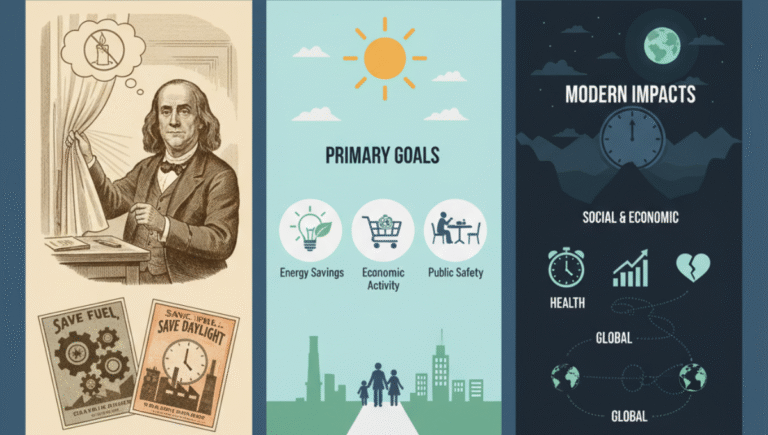Every spring and fall, millions shift their clocks an hour ahead or back to follow Daylight Saving Time (DST). While the ritual is familiar, many still wonder why we do it, when it happens, and whether it still serves its purpose today. In 2025, the debate around daylight saving is as strong as ever, but before diving into the controversies, let’s break down the basics: when it begins, why it exists, and how it impacts daily life.
Daylight Saving Time 2025: Start and End Dates?
In most places that observe it, Daylight Saving Time begins in spring and ends in fall. The exact dates for 2025 are:
-
Start: Sunday, March 9, 2025 – clocks move forward one hour at 2:00 a.m. (commonly known as “spring forward”).
-
End: Sunday, November 2, 2025 – clocks move backward one hour at 2:00 a.m. (often called “fall back”).
This shift means longer daylight in the evenings during spring and summer, but darker mornings until later in the day. In November, the clocks return to “standard time,” with earlier sunsets but brighter mornings.
Why Do We Change the Clocks?
The practice of Daylight Saving Time traces back more than a century. The concept is straightforward: moving clocks ahead in spring extends evening daylight, allowing people to enjoy more sunlight during active hours.
Historical Roots
-
The concept was first suggested in the late 1800s by Benjamin Franklin as a way to conserve candles, though it wasn’t formally adopted until World War I.
-
During both World Wars, countries adopted DST to save fuel and energy.
-
In the United States, DST was standardized in 1966 under the Uniform Time Act, though states were given flexibility to opt out.
The Purpose
The primary goals of DST have been:
-
Energy savings: Less electricity use in the evenings.
-
Economic activity: Longer daylight hours encourage shopping, dining, and outdoor recreation.
-
Public safety: Extended daylight is believed to reduce accidents after work or school.
Does Daylight Saving Time Really Save Energy?
Originally, one of the biggest arguments for DST was its potential to conserve energy. Longer evenings meant less reliance on artificial lighting. Modern findings suggest the issue isn’t as straightforward as once thought.
-
Studies suggest energy savings are modest or negligible today, as modern households use more energy for air conditioning and electronics than for lighting.
-
In some regions, DST may even increase energy consumption due to higher evening cooling demand.
While energy efficiency may no longer be the strongest justification, other social and lifestyle benefits still keep the practice alive.

The Effects of Daylight Saving Time
Changing the clocks is not just about schedules—it has real impacts on health, productivity, and daily routines.
Health Impacts
-
Sleep disruption: The “spring forward” shift can temporarily reduce sleep quality, leading to fatigue.
-
Cardiovascular health: Research has found a brief increase in heart attacks and strokes following the clock change.
-
Mental well-being: Longer daylight hours in the evening can improve mood and reduce symptoms of seasonal depression.
Social and Economic Impacts
-
Business boost: Retailers and restaurants often see increased activity when evenings stay lighter longer.
-
Transportation and safety: While the spring transition may briefly increase accident risks, extended daylight can reduce pedestrian and traffic accidents overall.
-
Global coordination: For international business and travel, DST can complicate scheduling as not all countries participate.
Who Observes Daylight Saving Time in 2025?
DST is not universal. Participation varies widely:
-
United States & Canada: Most states and provinces observe DST, except for places like Hawaii, Arizona (excluding Navajo Nation), and parts of Canada’s Saskatchewan.
-
Europe: The European Union still observes DST, though debates continue about abolishing it.
-
Middle East & Latin America: Some countries observe DST, while others do not, depending on local needs.
-
Asia & Africa: Nations close to the equator largely skip DST because daylight stays fairly constant throughout the year.
The Debate: Should Daylight Saving Time End?
In recent years, opposition to DST has grown. Critics argue that the practice is outdated and disruptive.
Arguments Against DST
-
Health risks: The biannual clock change can harm sleep and health.
-
Limited energy benefits: Modern lifestyles reduce the savings once promised.
-
Confusion and inconvenience: Travelers, businesses, and digital systems must constantly adjust.
Arguments for DST
-
Extended daylight in the evenings: Perfect for shopping, recreation, and outdoor sports.
-
Public safety benefits: Fewer accidents in the evening commute.
-
Cultural tradition: For over 100 years, DST has been part of daily life in many regions.
In the United States, several states have passed legislation to stay on permanent Daylight Saving Time or permanent Standard Time, though federal approval is required for changes. In Europe, discussions about ending DST altogether have gained traction, but implementation has been delayed.
What to Expect in 2025
For 2025, most regions that currently observe DST will continue as usual—“spring forward” in March and “fall back” in November. However, the global conversation about whether to keep or abolish the practice will likely continue.
People can expect the same routine adjustments:
-
Losing one hour of sleep in March but gaining it back in November.
-
Longer, lighter evenings arrive in spring and summer, while winter brings quicker nightfall.
-
The annual debate about whether we should continue adjusting clocks at all.
Final Thoughts
Daylight Saving Time remains one of the most enduring—and debated—timekeeping traditions in the modern world. In 2025, the practice will continue to affect billions of people, offering longer evenings in summer but sparking familiar complaints about sleep disruption and confusion.
Whether it stays or eventually ends, DST is a reminder of how deeply human societies are shaped not just by the sun’s cycles but also by our choices in how we measure time. For now, mark your calendar: on March 9, 2025, clocks move forward an hour, and on November 2, 2025, they shift back.
